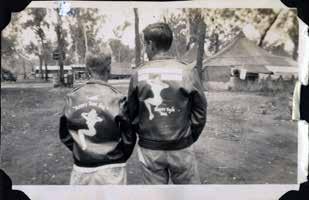
1 minute read
Origins and Evolutions of Aviation Nose Art

By Brittany Strobel Processing Archivist
Advertisement
Much like a person would add bumper stickers to a car or hang fuzzy dice on a rear-view mirror, nose art on airplanes grew out of the crewmen’s desire to personalize their crafts. Beginning in World War I, European forces decorated their planes with fierce animals, family crests, and other symbols. When the American forces arrived, they quickly followed the Europeans' lead and decorated their planes in addition to marking them with the newly required unit insignia.
Rodney Williams, a Delafield, Wisconsin resident, served in the 17th Aero Squadron in World War I. Williams trained in Waco, Texas after training in Canada. Pictured here is a training plane with a dog and the words “Who Said Rats” beneath it. While not nose art, this artwork distinguishes this plane from the others, and can be referenced as early personalization of aircraft. WVM.1070.I030
During World War II, nose art became an extremely popular means of distinguishing planes, creating a group identity, and bonding crew to craft. Nose art themes ranged from the popular pin-up model to lucky symbols, mascots, scenes of victory, and landscapes. While use of the female form became iconic, viewed today the portrayal of women as objects is offensive; the stereotyped depictions of other groups are likewise objectionable and racist. Because of the evolution of accepted norms and museum editorial standards, most of the nose art images in the collection are unpublishable. Even during WWII, military regulations prohibited the more risqué-style work, but with troops around the world, regulations like this were hard to enforce and were often overlooked in favor of building morale. To skirt the rules, some crews used water-soluble paints for their designs knowing that the next rainstorm would erase their mischief. Of course, not all nose art was controversial. There are also examples where the planes were nicknamed for sweethearts and wives.
Lawrence E. Roberts, a Dousman, Wisconsin resident, served with the Army Air Force Base Unit in World War II. Originally assigned as a tail gunner on a B-24 bomber bound for Europe, Roberts was unexpectedly held back due to a burst appendix. The other members of his crew went to Europe while Roberts recovered from the near-death experience in the United States. Roberts was then sent to Australia, and served as a crew member on a B-24 Liberator, Sleepy Time Gal. Seen here on the nose of the craft and the backs of the crew’s jackets, the Sleepy Time Gal features a pin-up model used on other aircraft around the world. Due to an injury he suffered on board another craft, Roberts was recuperating when the Sleepy Time Gal crashed into the Timor Sea, all hands lost. WVM.2127.I033.03, 34.04, 36.02







